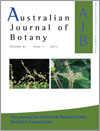Australian Journal of Botany
Volume 61
Number 1 2013
Ex-situ seed storage in gene banks has become an important tool for conserving threatened Australian plants; however, there is scant information about the seed longevity of most species. The seed viability equation was fitted to two contrasting Australian species, Eucalyptus erythrocorys F.Muell. (Myrtaceae) and Xanthorrhoea preissii Endl. (Xanthorrhoeaceae). A discussion of the fitting process and predictions of seed longevity are presented.
Limitations in our capacity to establish the time since fire of long-unburnt stands constrains our understanding of the rate of development of ecosystem features. We used growth-ring counts and growth ring–size relationships to estimate the time since fire of Eucalyptus salubris woodlands in south-western Australia. The estimated age-class distributions provide a substantial advance on those derived from remote sensing, although there remains significant uncertainty in the true time since fire of stands burnt over 200 years ago.
The occurrence of dry rainforest species in subhumid climates in Australia has been attributed to them being more drought resistant than their close relatives from mesic rainforests and also to their preference for loamy soils. Our glasshouse study provides the first experimental support for these ideas; dry rainforest seedlings had higher drought survival than mesic congeners and mortality was generally lower on loamy than sandy soils. This supports the idea that drought resistance of seedlings can shape tree species distributions at regional scales.
The objective of the present study was to evaluate the relative importance of asexual v. sexual recruitment in the post-fire recovery in semiarid steppe on the Loess Plateau, China. The results showed that fire significantly increased offspring recruitment numbers, but not species richness. The increase in asexual recruitment after a fire made a major contribution to the increase in total offspring number.
High mountain ecosystems are vulnerable to the effects of climate warming and Australia’s alpine vegetation is particularly vulnerable. Between 2004 and 2010, we monitored vegetation changes in a warming experiment within alpine open grassy-heathland. Our results suggest that Australian alpine vegetation has a degree of resilience to climate change in the short to medium term (20–30 years). In the long term (>30 years), drought may be as important a determinant of environmental change in alpine vegetation as rising temperatures.
Hybridisation is a common phenomenon in eucalypts, including artificial hybrids developed for forestry plantations; however, how trees are affected by this process varies. We examined the foliar chemistry of Corymbia hybrids and note that the species of the parents of a cross are important in determining the resulting chemistry of their offspring. This has implications for plant–insect herbivore interactions because this plant chemistry affects how insects find and consume trees.
Only limited numbers of plant species are pollinated by both wind and insects (ambophily), and whether and when ambophily is advantageous has not been studied well. The present study revealed that the pioneer plants Mallotus japonicus and M. wrayi are both ambophilous. Floral characteristics adapted to both wind and insect pollination indicated that ambophily is maintained in the two species for adaptive reasons. We also discuss potential factors related to the maintenance of ambophily in these two pioneer species.
Plant tissue-culture techniques are potentially useful for safeguarding the germplasm of rare or threatened taxa and have become increasingly popular for ex situ conservation. In the present study, an efficient in vitro clonal propagation protocol was described for S. kotschyana, which is a halophytic endemic and threatened species in Turkey. This regeneration protocol could be used for ex situ conservation of the species.
Increasing the above-ground biomass of Callitris endlicheri or C. glaucophylla did not negatively affect the number of species per plot. The number of species per plot remained unchanged under various densities of C. endlicheri and increased under moderate to higher densities of C. glaucophylla. The life form distribution of species changed under increasing densities of C. Glaucophylla, with herbaceous species becoming more prominent.




